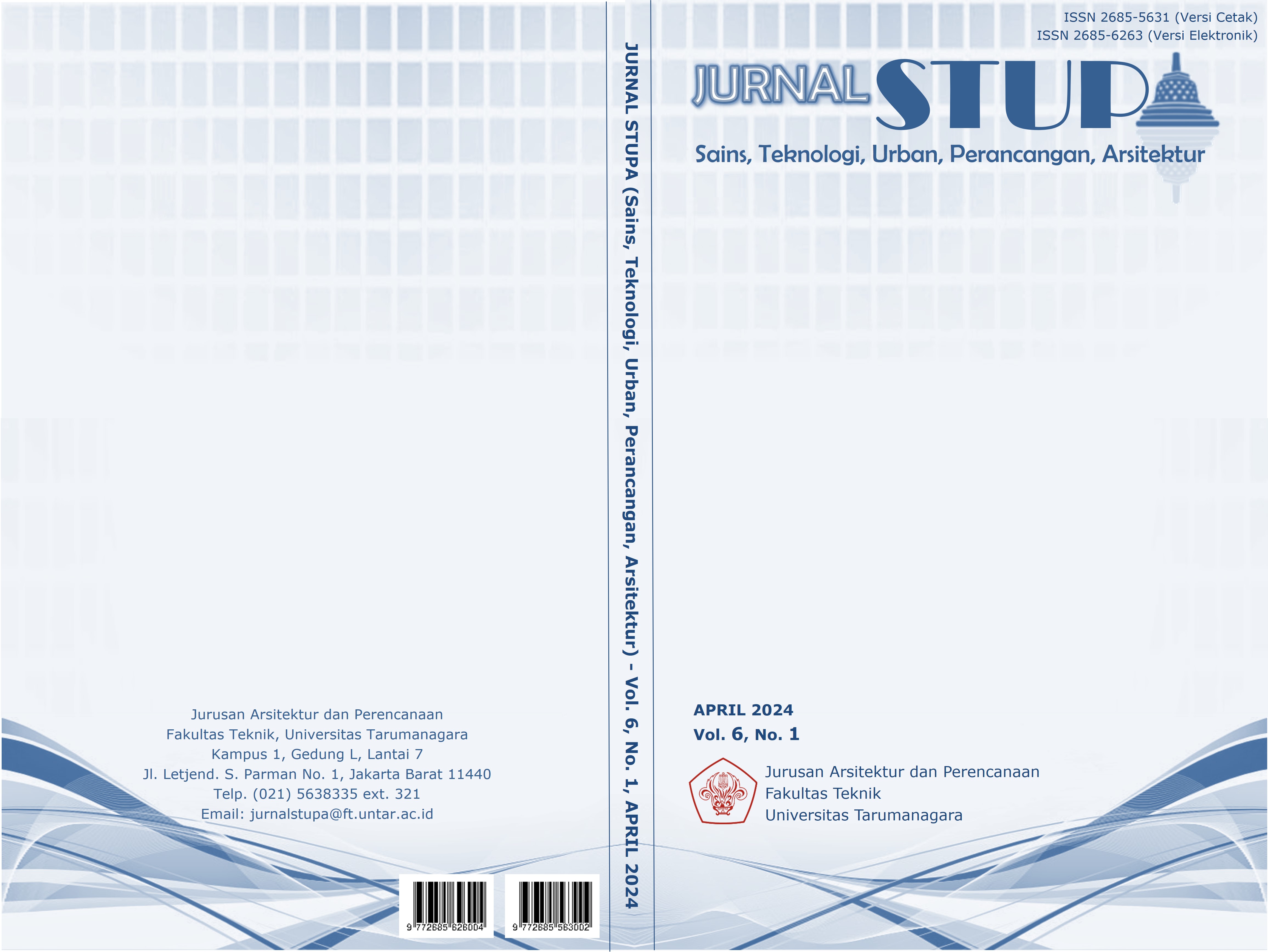PENDEKATAN ARSITEKTUR TERAPUTIK DALAM PERANCANGAN RUMAH TERAPI YANG AMAN BAGI PEREMPUAN KORBAN PELECEHAN SEKSUAL
Main Article Content
Abstract
In recent years there has been a significant increase in the occurrence of sexual violence and harassment where almost 78% of victims of sexual violence and harassment are women ranging in age from 8 to 18 years. This high level of violence has resulted in the growth of victims who have experienced trauma from the events that have happened to them. In this case, empathy architecture plays a role in providing a safe recovery space for women victims of sexual violence. Therefore, using the therapeutic concept, this study aims to explore design approaches for safe spaces for victims to recover and treat their trauma so that victims can slowly return to the social sphere and live their lives. The research method is to make field observations of the needs of therapy rooms, study of precedents related to therapeutic architecture including tracing coping mechanisms, therapy houses, and safe spaces. The findings of this study refer to the architecture of empathy that has a spatial effect, differences in the form and level of impact of sexual violence on victims, the stages of the type of therapy and its effect on the spatial and therapeutic architecture in creating a safe therapeutic home.
Keywords: empathic architecture; safe space; sexual assault; therapy home; trauma
Abstrak
Dalam beberapa tahun terakhir telah terjadi peningkatan yang signifikan dalam terjadinya kekerasan dan pelecehan seksual yang dimana hampir 78% korban kekerasan dan pelecehan seksual merupakan Perempuan yang memiliki rentang umur 8 - 18 tahun. Tingginya tingkat kekerasan ini mengakibatkan bertumbuhnya juga korban yang mengalami trauma akan kejadian yang telah menimpanya. Dalam hal ini, arsitektur empati berperan dalam menyediakan ruang pemulihan yang aman bagi para Perempuan korban kekerasan seksual. Maka dari itu dengan menggunakan konsep teraputik, penelitian ini bertujuan untuk menelusuri pendekatan perancangan bagi ruang yang aman bagi korban untuk memulihkan dan mengobati traumanya sehingga korban dapat secara perlahan kembali kedalam lingkup sosial dan menjalani kehidupannya. Metode penelitiannnya adalah dengan melakukan observasi lapangan terhadap kebutuhan ruang terapi, olah studi terhadap preseden terkait dengan arsitektur teraputik termasuk penelusuran coping mechanism, rumah terapi, dan ruang aman. Temuan penelitian ini merujuk pada arsitektur empati yang berpengaruh secara spasial, perbedaan bentuk dan tingkatan dampak kekerasan seksual terhadap korban, tahapan jenis terapi dan pengaruhnya terhadap keruangan dan arsitektur terapeutik dalam menciptakan rumah terapi yang aman.
Article Details

This work is licensed under a Creative Commons Attribution-NonCommercial-ShareAlike 4.0 International License.
This work is licensed under a Jurnal Sains, Teknologi, Urban, Perancangan, Arsitektur/ STUPA Creative Commons Attribution-NonCommercial-ShareAlike 4.0 International LicenseReferences
Bartlett, J. D., Griffin, J.L., Spinazzola, J., Goldman Fraser, J., Noroña, C.R., Bodian, R., … Barto, B. (2018). The impact of a statewide trauma-informed care initiative in child welfare on the well-being of children and youth. Children & Youth Services Review, 84, 110-117.
Chrysikou, E. (2014). Architecture for psychiatric environments and therapeutic spaces. Ios Press.
Dewi, R. M. (2007). Terapi Penyimpangan seksual lesbian menurut islam. Skripsi. UIN Raden Fatah.
Harvard Law School Halt (2021). How to Avoid Victim Blaming. Retrieved from Bartlett et al. (2017).
Jones, R., Tarter, R., & Ross, A. M. (2021). Greenspace interventions, stress and cortisol: a scoping review. International journal of environmental research and public health, 18(6), 2802.
Krug, E. G., Mercy, J. A., Dahlberg, L. L., & Zwi, A. B. (2002). The world report on violence and health. The lancet, 360(9339), 1083-1088.
Kusumawardani, A., Yuliani, S., Purwani, O., & Santi, M. (2022). Implementasi Konsep Therapeutic Space pada Strategi Desain Pusat Rehabilitasi Penderita Depresi. ARSITEKTURA, 20(2), 365-378.
Melania, M., & Fahmi, E. (2021). Meng-empu-kan perempuan: Desain ruang publik yang aman dan nyaman bagi pekerja perempuan di SCBD-Jakarta. Jurnal Muara Sains, Teknologi, Kedokteran dan Ilmu Kesehatan, 5(2), 513-526.
Miller, S. (2017). Many Women Experience Paralysis During Sexual Assault. Diakses dari https://www. livescience. com/59388-sexual-assault-paralysis. html.
Möller, A., Söndergaard, H. P., & Helström, L. (2017). Tonic immobility during sexual assault–a common reaction predicting post‐traumatic stress disorder and severe depression. Acta obstetricia et gynecologica Scandinavica, 96(8), 932-938.
Porcelan J, Scribner K. Brief Psychodynamic Psychotherapy: A Review and Illustrative Case Vignette. Innov Clin Neurosci. 2022 Jan-Mar;19(1-3):52-55. PMID: 35382069; PMCID: PMC8970238.
Rachmatunisa, N. R., & Rahmandani, A. (2023). “Apakah Aku Masih Memiliki Harapan? Studi Kualitatif Fenomenologi Pengalaman Ibu Korban KDRT Hingga Memutuskan Bercerai”. Jurnal EMPATI, 13(1), 63-69. https://doi.org/10.14710/empati.2024.27699
Ramadhani, S. R., & Nurwati, R. N. (2023). DAMPAK TRAUMATIS REMAJA KORBAN TINDAKAN KEKERASAN SEKSUAL SERTA PERAN DUKUNGAN SOSIAL KELUARGA. Share: Social Work Journal, 12(2), 131. https://doi.org/10.24198/share.v12i2.39462
Salamor, Y.B., & Salamor, A.M. (2022). Kekerasan Seksual Terhadap Perempuan (Kajian Perbandingan Indonesia-India). Balobe Law Journal, 2(1), 7-11.
Shapiro F, Snyker E, Maxfield L. EMDR: eye movement desensitization and reprocessing. Comprehensive Handbook of Psychotherapy, Cognitive-Behavioral Approaches. In: Kaslow FW, Patterson T, editors. West Sussex, UK: John Wiley & Sons.; 2004. pp. 248–254.
Tempo.co (2019). Baiq Nuril: Saya Tak Akan Menyerah Mencari Keadilan.



